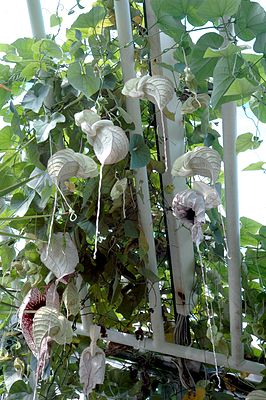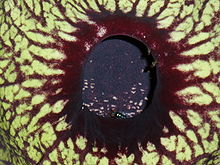Aristolochia grandiflora
| Aristolochia grandiflora | ||||||||||||
|---|---|---|---|---|---|---|---|---|---|---|---|---|

Aristolochia grandiflora |
||||||||||||
| Systematics | ||||||||||||
|
||||||||||||
| Scientific name | ||||||||||||
| Aristolochia grandiflora | ||||||||||||
| Sw. |
Aristolochia grandiflora , in German sometimes also called Großblumige Pfeifenblume or Großblumige Osterluzei , is a type of plant from the genus of the pipe flowers ( Aristolochia ), whose distribution area extends from Central America to northern South America. With a maximum total length of several meters, the flowers are the largest of all Central American plant species and are among the largest flowers in the world. The flower goes through a fertilization cycle lasting several days, in which flies are first lured into the interior of the flower, kept there for a day and then released again.
description
Habit and leaves
Aristolochia grandiflora is a long-growing, creeping climber . The older rungs are corky and stiff. The simple, dark green leaves are ovoid-heart-shaped, pointed to pointed at the tips, strongly heart-shaped at the base, 8 to 15 cm wide and 10 to 20 cm long. The upper side of the leaf is smooth, the underside of the leaf is curly hairy in young leaves and is also smooth and somewhat lighter in older leaves. In contrast to other species of the genus, there are no false secondary leaves.
blossom
The strongly zygomorphic , hermaphrodite and pre-female flowers stand individually in the leaf axils, the flower stalks have a bract . During the flowering period, they sometimes smell strongly of carrion . The calyx, consisting of a sepal , is conspicuously curved twice, 12 to 20 cm long and usually has a diameter of 20 to 50 cm, sometimes more. At the tip of the leaf lip it is provided with an extension up to several meters long. The total length of the flower including the appendage can exceed 4.5 m. The bends divide the chalice into several areas. The so-called kettle, which contains the stamen and stigma , hangs directly on the flower stalk . This is teardrop-shaped and bumpy and about 6 to 18 cm long. The adjoining trap protrudes with a mouth diagonally up into the kettle. The mouth is cylindrical and up to 4 cm long, the upturned trap is about 7 to 15 cm long. The entrance between the lip and the trap (also called the annulus) is thin and sharp-edged. The lip connects directly to the annulus and trap, is marbled purple, white, yellow, red and green; the interior of the flower is deep purple. The six-lobed scar column is crown-shaped, about 1.5 cm high and 1 cm wide. The six anthers are equidistant from the scar pillar.
fruit
The fruit is a cylindrical, 10 cm long and 4 cm wide capsule . It jumps to the point, has a split wall with six valves and contains a large number of seeds arranged in vertical rows. The seeds are triangular, flat, depressed horizontally, about 1 cm wide and 1.2 cm long and have a thickness of about 2 mm. In the semen there is a rudimentary, basal embryo in abundant endosperm .
Distribution and locations
The distribution area of Aristolochia grandiflora extends from Mexico to Central America to Panama and Colombia , it occurs mainly on the Atlantic coast of Central America, but can also be found on the Pacific coast . It is also native to Cuba , Jamaica and Trinidad ; the occurrences on St. Thomas , Guadeloupe and Martinique are possibly overgrown crops.
The sites are usually in damp thickets, often on river banks. It grows on medium-high trees and partially covers them almost completely. Mainly it is to be found in the "Tierra Caliente" called warm altitudes below 600 meters, where it is a common plant of the secondary forest . The plants rarely grow at heights of up to 1000 meters, but in extreme cases also up to 1300 meters.
ecology
pollination
Pollination takes place by a complex mechanism that attracts flies over several days , keeps them captive and finally releases them again. Just one day before the opening of the flower flows through a carrion from -like odor, which further strengthened with the opening of the flower in the early morning.
On the first day of flowering, the fish trap and lip are at an angle of about 28 ° to the axis of the kettle, so that insects can fly in. At this point the flower is in the female flowering phase, that is, the stigma is fertile, but the anthers are still closed and do not give off any pollen. The trichomes in the trap are directed inwards and are stiff and rigid, so that insects can penetrate the inside of the flower but cannot return. At the top of the bowl, the fabric is translucent, creating a kind of window through which light falls and draws visitors further inside the flower.
Observations showed that beetles and small flies from the humpback family (Phoridae) in particular visit the flower immediately after the flower has opened. Later in the morning, however, mainly larger flies from the blowfly families (Calliphoridae), rocking flies ( Sepsidae), real flies (Muscidae) and barn flies (Heleomyzidae) as well as humpback flies come to the flowers. From noon on the first day of flowering, the visitor rate drops drastically, but the flowering remains open until the next day.
On the morning of the second day of flowering, the trap and the lip of the flower inclines forward so that they are at an angle of about 60 ° to the axis of the kettle. In addition, the trichomes inside the flower attach to the inner wall and the tissue at the top of the kettle darkens. This enables the captive flies of the flower to leave it again. Beetles that are inside the flower usually cannot leave it. The carrion odor of the flower has almost completely disappeared at this point. The anthers that have already burst open then release the pollen with which the flies are covered when they fly out of the plant and thus fertilize another flower.
On the third day of flowering, it begins to wither very quickly, falls off the plant or begins to self-digest . The fallen flower dries out very quickly, usually within two days. It is unclear whether and how beetles that are still in bloom can free themselves from it and also contribute to pollination.
Relationship to other animals
Aristolochia grandiflora is one of the forage plants of the caterpillars of various species of the butterfly genus Parides and the species Battus chalceus , all of which belong to the knightly butterfly family (Papilionidae). During investigations into the spread of a viral disease in Honduran banana plantations, aphids of the species Aphis gossypii were discovered on the back of open flowers and on the underside of the leaves of Aristolochia grandiflora and thus identified as a possible intermediate host in the transmission of the disease.
Systematics
Aristolochia grandiflora is placed within the approximately 500 species comprehensive genus Aristolochia in the subgenus Aristolochia . Within this subgenus, the species forms the center of the Aristolochia grandiflora complex, to which the species Aristolochia pichinchensis and Aristolochia gorgona are still assigned. All species of this complex have a chromosome number of . For a long time these species were included in the Howardia series, which contains the American species of the subgenus. Phylogenetic studies could not confirm this classification, so that the series was split into two New World series. The following cladogram of the subgenus Aristolochia shows a possible classification of the Aristolochia grandiflora complex, but the results are not yet fully confirmed. The genus Euglypha seems to be a sister clade to the Howardia series, but some species have been removed from this series, so that only a part of it (pro parte) remains.
|
|
|
||||||||||||||||||||||||||||||||||||||||||||||||
|
|
use
Reports on - often shamanic and scientifically unproven - medical uses of Aristolochia grandiflora are diverse, so the plant is used against asthma , depression , malaria , rheumatism , constipation , menstrual cramps , cholera , yellow fever , rage , tetanus and syphilis as well as diseases of the Liver inserted. One of the best known is its use as an antidote for snake bites.
Medical studies in mice showed that an extract of Aristolochia grandiflora in about 30% of the experiments, the effect of the poison of the family of pit vipers belonging snake Bothrops atrox neutralized. It has also been reported that the roots are said to be toxic to pigs and other animals.
All drugs of the genus Aristolochia, including homeopathic dilutions up to D10, are considered dubious because of the high genotoxic , especially carcinogenic , and also nephrotoxic potential of the aristolochic acids they contain . According to § 5 AMG (Law on the Traffic in Medicinal Products) it is forbidden to bring drugs that are considered questionable into the market or to use them on people.
swell
- ↑ a b c Howard W. Pfeifer: Revision of the North and Central American Hexandrous Species of Aristolochia (Aristolochiaceae). In: Annals of the Missouri Botanical Garden , Volume 53, Number 2, 1966. Pages 115-196. doi: 10.2307 / 2394940
- ^ A b c Carlos Toledo Rizzini: Flora of Panama. Part IV. Fascicle III. In: Annals of the Missouri Botanical Garden , Volume 47, Number 4, Nov. 1960, pp. 263-359.
- ^ A b María Angélica Bello, Hamleth Valois-Cuesta and Favio González: Aristolochia grandiflora Sw. (Aristolochiaceae): Desarrollo y morfologie de la for mas large del mundo. In: Botánica , Volume XXX, Number 115, June 2006
- ↑ Paul C. Standley: Flora of Guatemala, Part IV. Field Museum of Natural History, Fieldiana Botany, Volume 24, Part 4. Chicago, USA, 1946.
- ↑ KS Burgess, J. Sing Field, V. Melendez and PG Kevan: Pollination Biology of Aristolochia grandiflora (Aristolochiaceae) in Veracruz, Mexico. In: Annals of the Missouri Botanical Garden , Volume 91, 2004. Pages 346-356.
- ↑ Hermann Cammerloher: On the biology of the flower of Aristolochia grandiflora Swartz. In: Österr. Bot. Z. , Volume 72, 1923. Pages 180-198. doi: 10.1007 / BF01660049
- ↑ Aristolochia grandiflora in Lepidoptera and some other life forms . Online, accessed September 16, 2007.
- ↑ Aristolochia's native to Belize at Biodiversity in Belize . Online, accessed September 20, 2007.
- ^ Carlos Evers: Host Plants of Sixteen Aphids from Banana Plantations in Honduras. In: The Florida Entomologist , Volume 51, Number 2, June 1968. Pages 113-118. doi: 10.2307 / 3493610
- ^ Stefan JU Wanke: Evolution of the genus Aristolochia - Systematics, Molecular Evolution and Ecology. Dissertation. Technical University Dresden. 2006.
- ^ R. Otero et al .: Snakebites and ethnobotany in the northwest region of Colombia. Part III: Neutralization of the haemorrhagic effect of Bothrops atrox venom. In: Journal of Ethnopharmacology , Volume 73, 2000. Pages 233-241.
- ^ Paul C. Standley: Flora of Costa Rica. Part II. , Field Museum of Natural History, Chicago, USA, 1937.
- ^ Revocation of authorization, Pharm. Ztg. No. 28 of August 9, 1981, page 1374.
Web links
- Aristolochia grandiflora information sheet from the Botanical Garden and Botanical Museum Berlin-Dahlem.
- Aristolochia grandiflora Profile and pictures at USDA Plants Database. (English)



